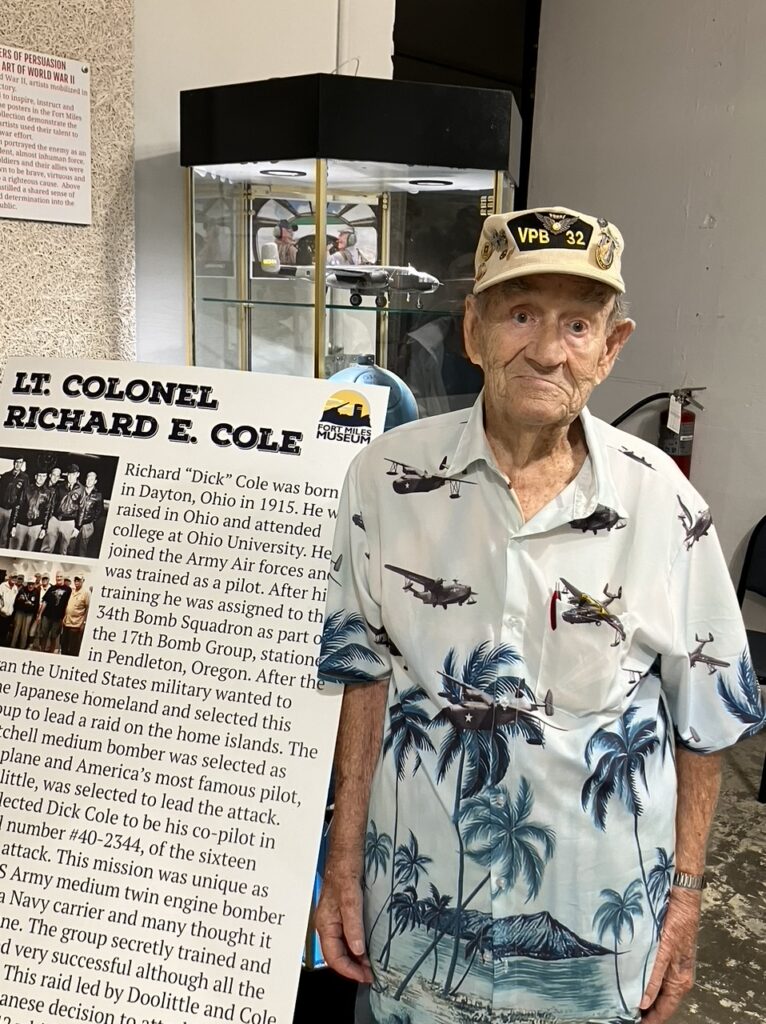Fort Miles Historical Association was pleased and proud to honor World War II Navy veteran AMMF 3/C John A. Reichert at its eighth annual ceremony recognizing VJ Day, the day the war ended in 1945.
Reichert was a Navy Aviation Machinist’s Mate and Flight Engineer during the war. He was born Oct. 28, 1924, in East Lansdowne, Pennsylvania.
Reichert entered the Navy in July 1943 and served on active duty until his honorable discharge in May 1946.

Patrol bombing squadron
In mid-1944, AMMF 3/C Reichert completed Combat Air Crew training in Dam Neck, Virginia, and was assigned as a flight engineer on a Martin PBM-5 Mariner aircraft for Patrol Bombing Squadron VPB-32, operating from Norfolk, Virginia.
The squadron’s mission was conducting anti-submarine training exercises, operational convoy coverage, and anti-submarine searches.
On Navy bombers and other multi-engine aircraft, the flight engineer is the plane’s systems expert with extensive mechanical and technical knowledge of aircraft apparatuses and performance. It is his responsibility to monitor and operate all aircraft systems. He is expected to diagnose and, where possible, correct or eliminate system faults. The flight engineer also is responsible for preflight and postflight aircraft inspections.
In April 1945, Squadron VPB-32 was ordered to the Western Seas Frontier Command at Naval Air Station Alameda, California, to provide security patrols of waters around San Francisco Bay during the United Nations Conference on International Organization.
After the conference, the squadron returned to Norfolk for training in new PBM-5E aircraft.
To the Pacific
At the war’s end in 1945, VPB-32’s mission shifted from the Atlantic fleet to the Pacific. Personnel and aircraft flew to NAS Alameda, then the squadron was transported aboard escort carrier USS Bogue, CVE-9, to Saipan in the Northern Mariana Islands.
In November 1945, VPB-32 began providing logistical support for Navy and Marine forces occupying the Japanese base at Truk in the Marianas; air/sea rescue standby; photo reconnaissance; and continuing training of pilots and crews.
In early March 1946, VPB-32 received orders to participate in Operation Crossroads, atomic bomb testing at Bikini atoll. The squadron’s first planes left their new home on Ebeye, a small island next to Kwajalein atoll, for the operations base for the tests. Their main mission was aerial logistic support for Bikini, which had no landing strip.
After the two atomic bomb tests in July, squadron planes flew over target sites to check for radioactivity while others took photos and assessed damage.
AMMF 3/C Reichert received his honorable discharge from the Navy on July 7, 1946, before the atomic bomb tests.
He returned to the Philadelphia area where he met and married Dorothy. They raised two sons and a daughter and, after a long stay in Philadelphia, John and Dorothy now live in Rehoboth Beach. The family planned to celebrate John’s 100th birthday Oct. 28, 2024.

